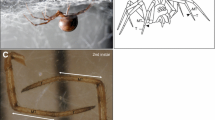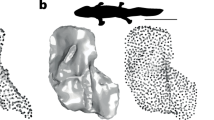A sophisticated dual support system enables a crab to stay mobile immediately after moulting.
Abstract
Like their aquatic counterparts, terrestrial crabs repeatedly shed their rigid exoskeleton during moulting. But in the case of land crabs, little water is available to provide a temporary hydrostatic skeleton before the new skeleton hardens, and air does not provide the buoyancy necessary to support the animal. Here we show that whenever its exoskeleton is shed, the blackback land crab Gecarcinus lateralis relies on an unconventional type of hydrostatic skeleton that uses both gas and liquid (a ‘pneumo-hydrostat’). To our knowledge, this is the first experimental evidence for a locomotor skeleton that depends on a gas. It establishes a new category of hydrostatic skeletal support and possibly a critical adaptation to life on land for the Crustacea.

Similar content being viewed by others
References
Drach, P. Ann. Inst. Océanogr. 19, 103–391 (1939).
Passano, L. M. in The Physiology of Crustacea Vol. 2 (ed. Waterman, T. H.) 473–536 (Academic, New York, 1960).
Skinner, D. M. in The Biology of Crustacea Vol. 9 (eds Bliss, D. E. & Mantel, L. H.) 43–146 (Academic, Orlando, 1985).
Reynolds, S. E. in Advances in Insect Physiology (eds Berridge, M. J., Treherne, J. E. & Wigglesworth, V. B.) 475–595 (Academic, London, 1980).
Miles, C. I. & Booker, R. J. Exp. Biol. 201, 1785–1798 (1998).
Hughes, T. D. Physiol. Entomol. 5, 153–164 (1980).
Cottrell, C. B. J. Exp. Biol. 39, 431–448 (1962).
Bliss, D. E. Am. Zool. 8, 355–392 (1968).
Bliss, D. E. Am. Zool. 19, 385–410 (1979).
Taylor, J. R. A. & Kier, W. M. Science 301, 209–210 (2003).
Chapman, G. Biol. Rev. 33, 338–371 (1958).
Chapman, G. J. Exp. Zool. 194, 249–270 (1975).
Clark, R. B. Dynamics of Metazoan Evolution (Clarendon, Oxford, 1964).
Author information
Authors and Affiliations
Corresponding author
Ethics declarations
Competing interests
The authors declare no competing financial interests.
Supplementary information
Supplementary information
(DOC 24 kb)
Rights and permissions
About this article
Cite this article
Taylor, J., Kier, W. A pneumo-hydrostatic skeleton in land crabs. Nature 440, 1005 (2006). https://doi.org/10.1038/4401005a
Received:
Accepted:
Published:
Issue Date:
DOI: https://doi.org/10.1038/4401005a
- Springer Nature Limited





